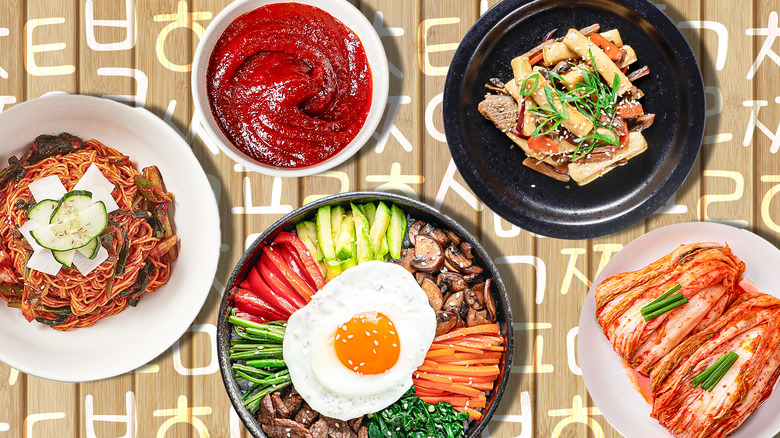“Feast for the senses.” A phrase often heard and over-used, but nowhere else does it apply so fittingly than a meal at a Korean restaurant. When you step into a gogi gui (pronounced go-gee-ku-i), a Korean barbecue, the scene is hard to forget with its hot grills surrounded by dozens of small and large dishes of condiments, meats, and veggies. At Korean noodle houses, the auditory bustle of clanking dishes and metal chopsticks makes an everlasting memory. But it’s not the visual and auditory senses that best explain Korean cooking’s continued rise in popularity — it’s the flavors and aromas, of course.
For example, kimchi — Korean fermented cabbage — is taking the world by storm with its vibrant, tangy, often fiery, qualities. Bibimbap, Korea’s hot rice bowls with the signature egg on top, allure diners with its contrast of fresh, piquant, pickled veggies, savory soy-marinated grilled meats, nutty sesame seeds, and rich, creamy egg.
Those two dishes are often encountered in Korean restaurants, along with many more words and phrases that you may be intimidated by. So let’s go through the essential terms you may come across at the table, moving through Korean appetizers, sides, and mains, and ending with beverages and desserts. Get ready to impress your friends with your deepened knowledge of this rich cuisine.
Note: All spellings are English approximations of Korean words. It’s not uncommon to run into different Romanizations of the same word, such as bulgoki and bulgogi. The most common spellings are used here.
Korean cooking and the three main sauces or jangs: gochujang, doenjang, ganjang
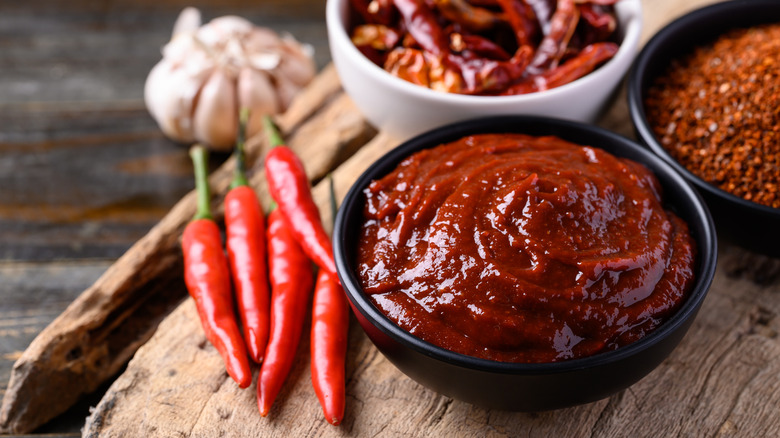
Three sauces, or jangs, make up the flavor foundation for almost all Korean cooking: gochujang, doenjang (pronounced den-jiang), and ganjang. Similar to the famous “mother sauces” of French cuisine, these jangs, with their bold, salty, fermented flavors, provide the base for most traditional Korean recipes and also take up permanent residence as dipping or spooning sauces on many Korean restaurant dining tables.
Gochujang, or fermented red chili paste, is a vivid red, and just as vividly flavorful, with aggressive heat from Korean red pepper flakes, or gochu garu. Chefs typically use it to flavor spicy noodle bowls and stir-fry dishes, and you can dollop some more when served for a fiery punch. Doenjang, fermented soybean paste, has a funky, pungent aroma from months or years of fermentation, but the flavor transforms into an umami-rich creaminess. Ganjang, Korean soy sauce, is noticeably rich and tangy compared to the more famous Japanese and Chinese versions. Traditionally made versions of ganjang do not contain the wheat found in many soy sauces.
Korean condiments at every table: the three jangs plus cheong, ssamjang, and chamgireum

A key and delightful aspect of Korean dining is the sheer number of dishes teeming on a typical table. The multitude of dishes illustrates a key component of the Korean dining experience — empowering the diner to customize, create, and enjoy their own personal flavor combinations.
A good portion of the dishes on a Korean restaurant table are condiments, including the gochujang, doenjang, and ganjang sauces that we’ve already mentioned.
Cheong, or syrup, is a common condiment, derived from mixing any number of different fruits with an equal amount of sugar and aging it for three to four months. This creates a sweet, sometimes spicy, drizzle on your grilled meats. Ssamjang, Korea’s main barbecue sauce, is made from gochujang and savory spices and often drizzled into lettuce or cabbage wraps. Its flavor profile moves in a sweeter direction than unadorned gochujang. Chamgireum is a simple, smoky, sesame oil often drizzled over grilled vegetables or meats or used to add richness to soups.
Pickled banchan (Korean side dishes): kimchi, kkakdugi, oi muchim, and ssam-mu
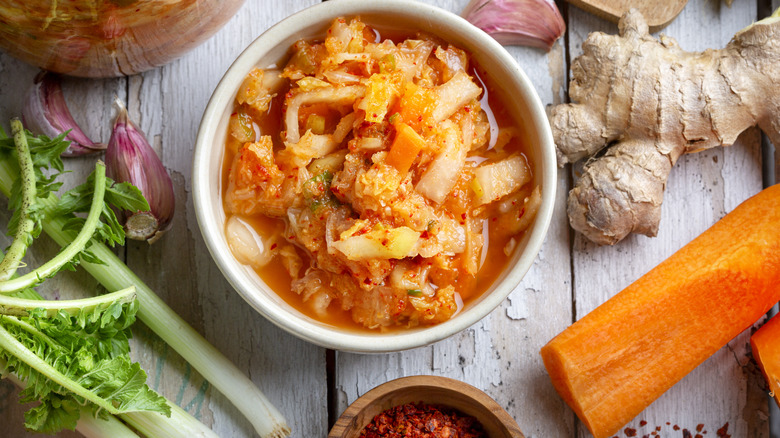
Ollo/Getty Images
After the small dishes of jangs and condiments come the slightly larger bowls and plates that hold banchan, a general term for Korean side dishes meant to be shared by the whole table. Banchan is a famously inclusive term, encompassing anything from gim — small crispy sheets of seaweed — to kong namul — spicy bean sprouts, and more.
Perhaps the most famous of the banchan is kimchi, a pungent, fermented blend of vegetables, Korean red chilis, garlic, and spices. Kimchi is most commonly made from fermented cabbage, but can often be made with carrots, radishes, green onions, and more. Much like how other cuisines use pickles, chutneys, or sauerkraut, kimchi is served cold or room temperature and used to accent almost any bite on the table. Kkakdugi (pronounced kak-du-gi) is in the kimchi family, focusing on radishes as its main fermented vegetable. It is often bright red and equally spicy.
Oi muchim, or pickled cucumbers, is a cool, vinegary side dish often incorporating cucumbers, green onions, and other summer vegetables. Ssam-mu, a quick-pickled radish, is another light, cool, piquant-sweet side dish perfect for nibbling between savory bites of grilled pork or eggplant.
Popular Korean appetizers: pajeon, japchae, and tteokbokki
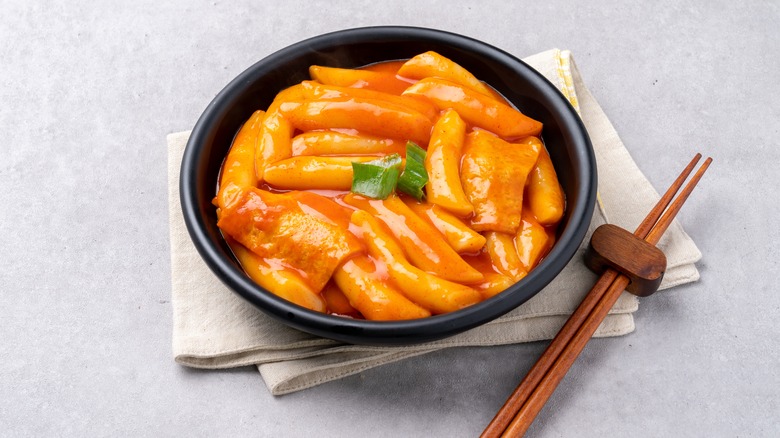
Hyeong-Taek Lee/Shutterstock
Appetizers play an important role in Korean dining. Often served in small three-to-four-bite servings, Korean appetizers are selected for how they pair with beer, plum wine, or other beverages, rather than the more common Western dining experience where wines or beer are chosen for how they’ll pair with food choices.
Thin, yellow, egg pancakes dotted with small ringlets of sliced green onion are called pajeon (pronounced pa-john). Savory, a little salty, and often served with a spicy side sauce, pajeon can be found on almost every Korean restaurant menu.
Japchae (pronounced jep-chay), a savory dish bringing together stir-fried, stretchy, thin noodles made from sweet potato starch, tender steamed veggies or meats, and soy sauce with sesame oil, comes mounded on small plates (or larger dishes if served as an entrée).
A major subset of Korean appetizers is varied and delicious rice cakes, including the ever-popular tteokbokki (pronounced dok-bo-kee). They are white, tootsie roll-shaped rice cakes nestled into a spicy, salty, savory gochujang-based sauce. The satisfying chewiness of the rice cakes counterpoints the softly resistant texture of fish cakes, often included in the dish.
Korean main rice dishes: bibimbap, kongnamul bap, and gimbap
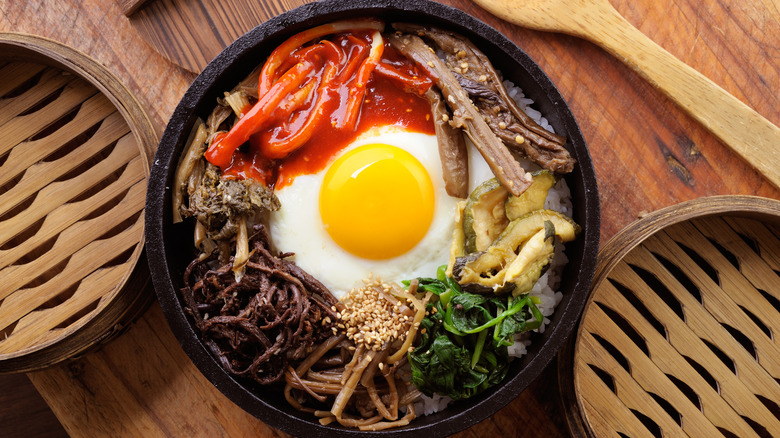
4kodiak/Getty Images
Once you learn that bap is Korean for rice, much of a Korean menu will instantly become a notch or two clearer. Rice in Korean cuisine takes on almost infinite forms as it is ground into flour, formed into noodles from gossamer-thin to finger-thick, served as fluffy or sticky sides, or processed into a paste.
A Korean menu rock star featuring rice is bibimbap. Colorful, generously-proportioned bowls start with steamed rice to which braised veggies and meats are added. Typically, a dollop of kimchi occupies a corner of the bowl, along with fresh cold pickled cucumbers and carrots, all topped with an iconic, golden-yolked, sunnyside-up egg.
Kongnamulbap, steamed rice with spicy soybean sprouts, is one of those savory vegetarian dishes that meat lovers, much to their surprise, find fully satisfying. As with most Korean rice dishes (and most other dishes, for that matter), a vibrant bunch of kimchi is tucked in topside.
Gimbap, seaweed-wrapped rolls, take rice in another direction. Similar in looks and shape to a large sushi roll, gimbap wraps a center of crunchy veggies and spicy meat with a layer of sticky steamed rice, all sealed up with a delicate, umami, thin sheet of gim (seaweed).
Korean noodle offerings: naengmyeon, kalguksu, and jajangmyeon
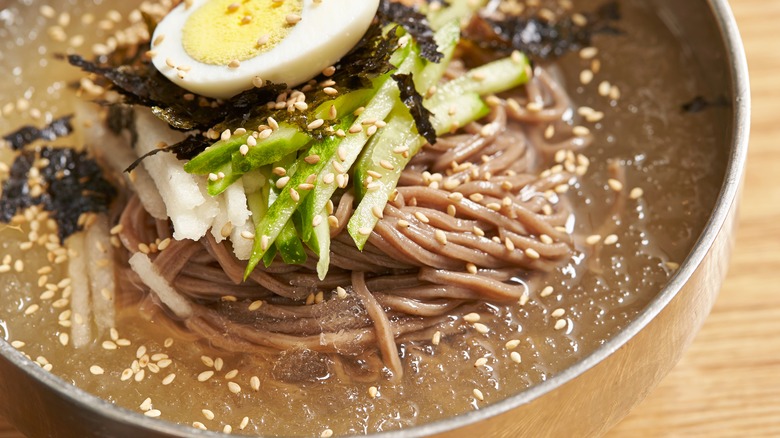
mnimage/Shutterstock
In Korean cooking, the ingredient used to make the noodles is embraced. From buckwheat to sweet potato, to wheat, and more, the flour that creates the noodle imbues it with its own flavor, color, and texture. A classic buckwheat noodle dish is naengmyeon (pronounced neng-myon). Served cold, the noodles are often organized into a cohesive bunch and placed in a clear broth with radishes, scallions, and cold pickled veggies on top.
Jajangmyeon is a much heartier dish, with robust wheat noodles coiled into a ball and topped with a thick, sweet brown sauce featuring cubed pork and sliced vegetables. Jajangmyeon, with its thick, dark, gravy-like sauce, creates a striking visual contrast to the lighter broths commonly found on Korean menus.
Flat, knife-cut noodles are featured in kalguksu, a bright, soupy option with a light, sesame-seasoned broth and strips of cooked cabbage. When served, the delicate, flat noodles will float lightly on top.
Korean grilled beef and pork: bulgoki, kalbi, and samgyeopsal
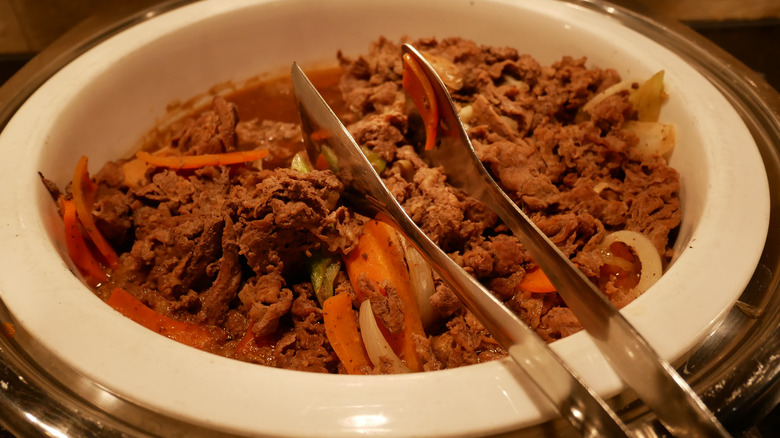
Niwat Sripoomsawatt/Shutterstock
Korean grilling and barbecuing are foundational aspects of the country’s dining experience. The most famous and widely popular meat in Korea’s grilling universe is bulgoki (often, you’ll see it spelled as bulgogi). Originally limited to thin-sliced beef marinated in soy sauce, sugar, green onions, and ginger, the dish now encompasses chicken, pork, and even mushrooms. The food is grilled on high heat to create a savory, sugary crust of the marinade, and bulgogi is usually served on rice with a refreshing side of pickled, crunchy veggies.
Kalbi, ultra-tender BBQ beef short ribs, are marinated for hours in soy sauce, rice wine, and minced ginger, then braised until pull-apart. They’re then finished on the grill, creating a crunch that gives way to the tenderness inside.
Samgyeopsal (pronounced sahm-gee-oh-psul) translates almost directly into “three layers of meat”. Thick slabs of pork belly, when grilled, break into flavorful layers of different texture and fattiness. When served, samgyeopsal is sliced into thin strips and often served with a cool salad.
Korean chicken dishes: dak twigim, dak kalbi, and dak bokkeumtang
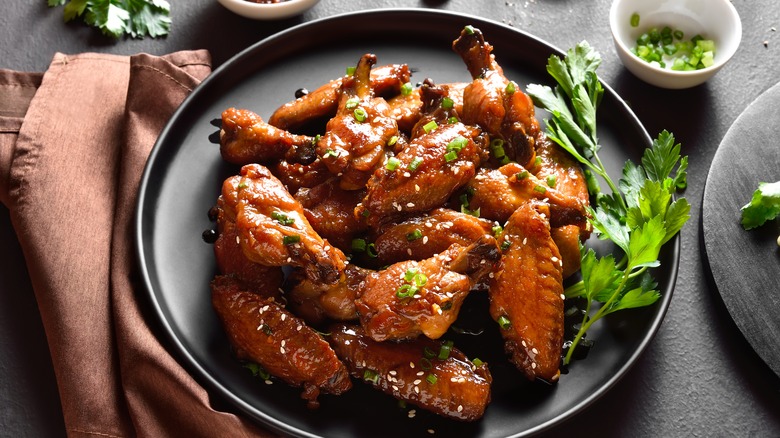
Tatiana Volgutova/Shutterstock
Chicken in Korean cuisine does not play the starring role of go-to meat that you might find in many other East Asian cooking traditions. That said, expect to find a rich and deep selection of varied chicken dishes, from skewers to soups to stews.
Korean fried chicken is a thing, a very good thing. Often simply called “fried chicken” even in non-English-speaking corners of Korea, you might see it referred to on a menu as dak twigim, with dak meaning chicken and twigim meaning crispy. Typically, fresh, chicken pieces are marinated for a short time in ginger and garlic, punching up the flavor, but not affecting tenderness. Dipped into starch (sometimes seasoned potato starch), the chicken pieces are fried, cooled, and fried again for paramount crispiness.
Dak kalbi is a stir-fry of tender chunks of chicken (often thigh or breast), sweet potatoes, and cabbage, all coated with a savory zing of spicy gochujang.
Dak-bokkeum-tang (pronounced dahk-boh-koom-tahng) is a brick red chicken stew, with fall-off-the-bone chicken pieces sharing a thick, salty-spicy, gochujang-based sauce with potatoes, carrots, and onion chunks.
Fish and shellfish on a Korean menu: haemul pajeon, haemul jjigae, and maeuntang
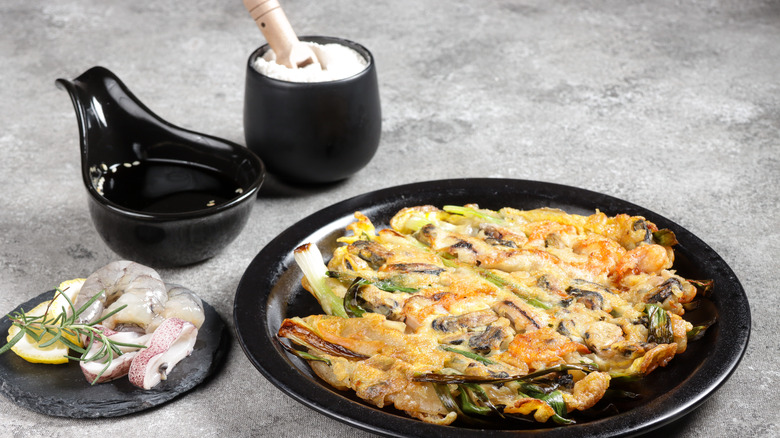
Sri Widyowati/Getty Images
Korea is a peninsular country, surrounded by the Sea of Japan to the east, the Yellow Sea to the west, and the Pacific to the south, and nowhere is that fact more evident than Korean cuisine’s embrace of seafood. Hence, squid, clams, cockles, mackerel, octopus, and much more often appear on Korean restaurant menus.
Haemul (pronounced hay-mool) means seafood, and haemul pajeon is seafood pancake. The pajeon recipe of egg and green onion gets a seafood boost here with bite-size pieces of shellfish and crustaceans. More substantial than the appetizer-sized pajeon, haemul pajeon is a staple in Korea’s seafood scene.
Haemul sundubu jjigae (jjigae is pronounced jee-gay) is a seafood stew featuring tender bites of shellfish and creamy soft tofu (sundubu) in a spicy red broth. Mushrooms, garlic, and green onion build the umami flavors to balance out the heat.
Korea’s maeuntang (pronounced may-oon-tahng) fish stew, featuring chunks of white fish, daikon radish, and green onion, gets its spicy reputation from tossing in generous amounts of gochu garu, Korean hot red pepper flakes. Keep a cool pickled salad nearby.
Popular Korean stews and soups: kimchi jjigae, yukgaejang, and sundubu jjigae
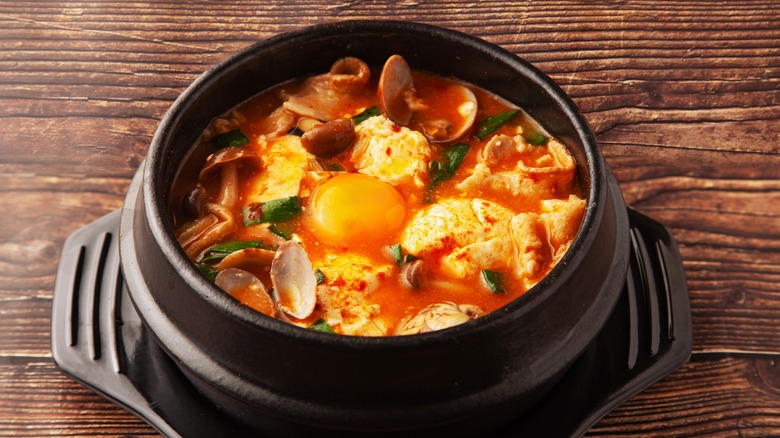
sasazawa/Shutterstock
Hearty, spicy stews and light, bright soups define much of Korea’s cuisine. They often incorporate a savory base with hot gochujang and branch out into other flavors with vegetables, meats, and seafood.
Kimchi jjigae, or kimchi stew, combines two defining Korean styles. Warmly embraced throughout the country, kimchi jjigae uses well-aged kimchi to infuse complex fermented flavors into the stew. Tofu and tender, braised pork belly add a warm counterpoint to the acid-forward kimchi flavors.
Yukgaejang (pronounced yook-gay-jahng), a spicy beef and vegetable soup, is thick enough to be called a stew. Tender shreds of beef add to the robust consistency, and thick-cut carrots, cabbage, and green onions round out the flavor. This is one of the longer-simmering stews you’ll find on a Korean menu, meaning it’s full of tenderness and a rich flavor.
Sundubu jjigae, spicy soft tofu stew, is another nationally popular dish. Don’t be alarmed when the tofu falls apart on your fork — it’s meant to add a rich, creamy texture, almost like sour cream. You’ll often find seafood in sundubu jjigae for added texture and depth of flavor.
Favorite Korean desserts and drinks: sikhye, misugaru, yaksik, and bingsu
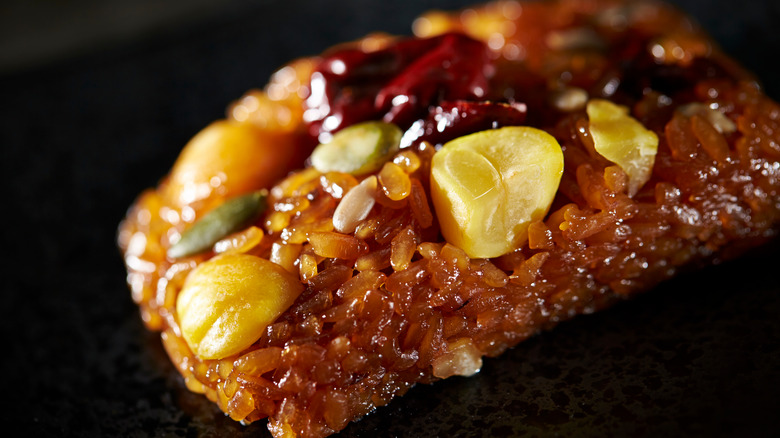
mnimage/Shutterstock
Eye-popping, show-stopping desserts that you might find in other cuisines are not a focus in most traditional Korean restaurants. But there are some favorites. Dessert often takes the form of a sweet drink or simple fresh fruit, sometimes served for free at the end of the meal.
One of Korea’s most common sweet drinks is sikhye (pronounced shik-heh), a traditional rice beverage. Refreshing and sweetened by the added syrup and sugars released from the soft, cooked rice, it should be served ice-cold with grains of tender rice floating on top. The textural experience may at first be challenging, and then will likely become your favorite drink on the menu.
Misu is another popular drink that tastes subtly sweet from a pureed blend of different toasted seeds and grains mixed with water or milk. It is a cool summer refresher.
Drinks aside, you can pick up a piece of yaksik — a sticky, sweet, nutty rice bar — for a true dessert experience. They come served with a drizzle of syrup and goes wonderfully with hot tea.
While dairy ice cream continues to gain in popularity in Korea, the country’s palate prefers the fresh tartness of a good shaved ice or bingsu, so that’s what you’ll often find at Korean restaurants. Sorbet-like flavors and colors fill a cold bowl, often served with slices of fresh berry or plum.
Common Korean alcoholic beverages: soju, maekju, and maesil ju
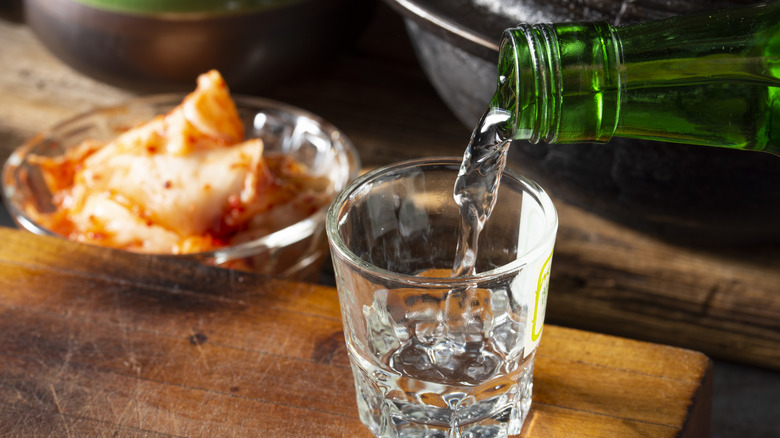
4kodiak/Getty Images
An entire, separate dining universe within Korea’s larger dining culture exists, called anju. Anju are bite-sized delectables, much like tapas, but they differ in that they are designed to be paired with Korea’s three main alcoholic beverages.
Soju, a crisp, light, brandy-strength liquor is Korea’s signature alcoholic beverage. Clear, sometimes with a slight cloudiness, soju is easy to sip and food-friendly. Made most commonly from sweet potato mash, soju is one of those discoveries you’ll wish you could find in your local grocery store. It’s best served very cold.
Maekju is beer, and Korea boasts as wide a variety of domestic-made beers as any other beer-making country. From stouts to ales and pilseners, Korean maekju goes well with Korean food.
Rounding out Korea’s big three alcoholic beverages is maesil ju or plum wine. Ranging from dry to sweet, but more often sweet, maesil ju has a lovely transparent topaz color and can range between 15 and 30% alcohol by volume.



